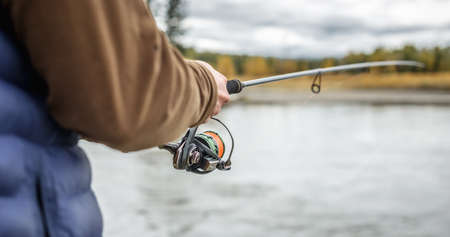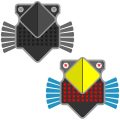Spring Bass Behavior and Feeding Patterns
When spring rolls around and the water starts to warm up, bass behavior changes in a big way. Understanding what makes bass tick during this season is the first step to crushing it with topwater lures.
How Warming Temperatures Affect Bass
Bass are cold-blooded, so as water temps climb into the upper 50s and 60s (°F), their metabolism kicks into high gear. This means they get hungrier and more active, moving out of their winter hiding spots and patrolling shallower waters where food is easier to find. Here’s a simple breakdown:
| Water Temperature (°F) | Bass Activity |
|---|---|
| Below 50 | Slow, sluggish, deep water |
| 50-60 | Increased movement, feeding up for spawn |
| 61-70 | Spawning, aggressive strikes on surface baits |
| Above 70 | Post-spawn, still feeding but may move deeper mid-day |
The Spawning Connection
During spring, bass move shallow to spawn. They build nests—called “beds”—in protected coves, flats, or near cover like logs and rocks. While guarding these nests, both male and female bass become highly territorial. If something moves above them or comes close to the nest—like a topwater lure—they’re quick to attack.
Why Bass Hammer Topwater Baits in Spring
This aggression isn’t always about hunger. In spring, it’s often about defending their turf. Surface lures mimic frogs, injured baitfish, or even small critters that could threaten eggs or fry. When you twitch a popper or walk-the-dog with a stickbait over a nesting area, expect explosive reactions from protective bass.
Key Takeaways for Spring Topwater Fishing
- Look Shallow: Target shallow flats, coves, and banks near spawning grounds.
- Fish Slow: Let your lure sit between twitches—bass need time to zero in.
- Mimic Threats: Use lures that resemble real threats to nests: frogs, bugs, and small fish.
- Watch for Follows: Sometimes bass will stalk your bait before striking—be patient!
Spring is all about timing and location. When you understand how bass behave as the water warms up and why they get so fired up by surface action, you’ll be ready to make every cast count with topwater lures.
2. Choosing the Right Topwater Lures
Picking the right topwater lure is key for spring bass fishing. The action, noise, and profile of your bait can make a huge difference in getting those explosive strikes. Let’s break down the most popular topwater lures for American anglers and when to throw each one.
Poppers
What they are: Poppers have a cupped face that spits water and makes a loud “pop” when you twitch them on the surface.
Best use: Early mornings or calm evenings when bass are feeding near shallow cover like docks, laydowns, or weed lines. Poppers work best in still water where their splash grabs attention.
Walking Baits (Stickbaits)
What they are: Slim lures designed to zig-zag or “walk-the-dog” across the surface.
Best use: Over open water or points with scattered baitfish. Walking baits shine in clear water when bass are hunting but not aggressively smashing baits. Their side-to-side action calls fish from a distance.
Frogs
What they are: Hollow-bodied, weedless baits that can be thrown into thick grass, lily pads, or matted vegetation.
Best use: When bass are hiding in heavy cover. Frogs are ideal for skipping across mats where other lures would get snagged. They’re also great for sunny days when fish bury themselves deep in weeds.
Buzzbaits
What they are: Wire baits with spinning blades that churn up a ton of surface commotion.
Best use: Covering lots of water fast, especially during low-light conditions or windy days. Buzzbaits excel around shallow flats, creek mouths, and over submerged grass where aggressive fish are willing to chase.
Bass Topwater Lure Comparison Table
| Lure Type | Main Feature | Best For | Prime Conditions |
|---|---|---|---|
| Poppers | Loud pop & splash | Shallow cover, dock edges | Calm water, morning/evening |
| Walking Baits | Zig-zag “walk-the-dog” motion | Open water, schooling baitfish | Clear water, light wind |
| Frogs | Weedless; skips across mats | Lily pads, thick grass mats | Bright sun, heavy cover |
| Buzzbaits | Noisy blade churns water | Casting over flats/grass beds fast | Dawn/dusk, windy/cloudy days |
The key is matching your lure to the cover and activity level of spring bass. Don’t be afraid to switch it up until you find what triggers those heart-pounding strikes!
![]()
3. Timing and Weather for Topwater Success
When it comes to catching spring bass on topwater lures, timing and weather can make or break your day. Knowing when bass are most likely to strike at the surface is a huge advantage. Let’s break down the best times and how different weather conditions can impact your topwater game.
Best Times of Day for Topwater Bass Fishing
| Time of Day | Bass Activity Level | Topwater Effectiveness |
|---|---|---|
| Early Morning (Sunrise) | High | Excellent |
| Late Afternoon (Sunset) | High | Excellent |
| Midday (Bright Sun) | Low to Moderate | Limited |
| Cloudy/Overcast All Day | Moderate to High | Very Good |
Bass are most active in low-light conditions like dawn and dusk. During these times, they move into shallow waters to hunt, making them more likely to hit surface lures. On cloudy or overcast days, this feeding window stretches out longer—sometimes all day long.
How Weather Conditions Affect Topwater Action
- Sunny & Calm: Bass are more cautious. Topwater bites slow down, especially during midday. Try smaller baits and quiet presentations near cover or shade.
- Cloudy/Overcast: Bass roam and feed more aggressively across flats and open water. Use louder, splashier lures to draw attention.
- Windy: A light breeze can help disguise your lure and break up the surface. Fish wind-blown banks where baitfish gather. Too much wind? Switch to heavier lures or target protected coves.
- Rain: Light rain often gets bass fired up on the surface, but heavy downpours make it harder for fish to track your lure. Adjust by using brighter colors or louder baits.
Tactics for Changing Conditions
- If sun pops out after clouds: Move to shaded areas or under docks where bass may retreat.
- If wind picks up: Target points, riprap, or weed edges facing the wind.
- If bite slows down midday: Downsize your lure and slow your retrieve, or switch briefly to subsurface baits until activity picks back up.
- If a front moves in: Expect bass to get tight-lipped; focus on precision casts near heavy cover with natural-looking lures.
The Bottom Line on Spring Topwater Timing
The right time and weather can turn an average trip into a topwater blowup fest. Pay attention to changing light and cloud cover, be flexible with your tactics, and you’ll connect with more spring bass on the surface.
4. Presentation Techniques to Trigger Strikes
Getting spring bass to smash your topwater lure is all about how you work it across the surface. American anglers have dialed in a handful of proven retrieves and actions that make bass go wild, especially in the shallows when water temps start climbing. Let’s break down some of the most effective techniques you can use this season.
Popular Topwater Retrieves
| Retrieve Name | How To Do It | Best Lure Types |
|---|---|---|
| Walk-the-Dog | With your rod tip down, twitch sharply while reeling in slack. The lure will zigzag side-to-side like a wounded baitfish. | Stickbaits (e.g., Zara Spook) |
| Popping & Chugging | Short, sharp pops with pauses between. The lure spits water and makes noise to attract bass from a distance. | Popper lures, chuggers |
| Buzzing | Steady retrieve at the surface. Buzzbaits create a wake and commotion that draw reaction strikes. | Buzzbaits, prop baits |
| Stop-and-Go | Reel in a few feet, pause, then repeat. Pauses often trigger strikes from following fish. | Poppers, frogs, stickbaits |
| Crawling Slow | Move the lure slowly with occasional twitches or shakes, mimicking an easy meal for lazy bass. | Frogs, soft plastics rigged for topwater |
The Power of Pauses and Cadence Changes
Bass aren’t always aggressive every minute—they might just be curious. That’s where mixing up your cadence comes in. Try alternating fast, erratic movements with long pauses. Sometimes bass will watch a lure for several seconds before deciding to strike right after you stop moving it. Especially during chilly spring mornings, slow things down and let the lure sit still to tempt cautious fish.
Troubleshooting Tough Bites
- If bass are just swirling under your lure but not biting, slow down and add longer pauses between twitches.
- If there’s no action at all, speed things up or switch to a noisier bait to get their attention.
- If you’re missing strikes, wait until you feel the weight of the fish before setting the hook—don’t set it just because you see a splash!
Tip: Match Your Lure Action to Conditions
On calm days, subtle retrieves often work best since too much commotion can spook bass. On windy or overcast days, louder popping or buzzing retrieves help them zero in on your bait.
5. Targeting Productive Spring Spots
Spring is prime time for topwater bass fishing, but knowing where to cast makes all the difference. As water temps rise, largemouth and smallmouth bass move up from their winter haunts to shallow areas to feed and spawn. Here’s how you can zero in on the best spring spots in both lakes and rivers.
Shallow Flats
Shallow flats warm up quickly in spring, drawing baitfish—and hungry bass. Early in the season, focus your casts over 1-4 feet of water, especially where sunlight hits most during the day. Look for:
- Muddy or sandy bottoms (they warm up faster)
- Patches of new grass or emerging weeds
- Areas near deeper drop-offs for quick escape routes
Points and Creek Mouths
Points jutting into a lake or river act like highways for moving fish. Bass will often stage here before heading shallow to spawn. Creek mouths also attract bait and offer fresh, oxygenated water. Work your topwater lures along these edges—especially early mornings or late afternoons when fish are most active.
Flooded Cover
Spring rains can raise water levels, flooding bushes, trees, and brush along shorelines. These provide perfect ambush spots for bass hunting prey near the surface. Cast your lure tight to the cover; don’t be afraid to skip it under overhanging limbs or between branches.
Common Flooded Cover Targets
| Type of Cover | Why It’s Productive |
|---|---|
| Bushes & Willows | Shelter & shade for big bass looking to ambush prey |
| Lily Pads & Grass Mats | Bass cruise under these mats, waiting for an easy meal |
| Docks & Walkways | Man-made cover often holds bass throughout spring |
Spawning Beds
When the water hits 60-70°F, bass start making spawning beds—round depressions in gravel or sand, usually near hard-bottom banks or protected coves. Look for clear water and watch for light-colored circles on the bottom. Approach quietly and toss your topwater lure just past the bed, then work it slowly across their strike zone.
Quick Guide: Spring Hotspots for Topwater Bass Fishing
| Location Type | Best Time to Fish |
|---|---|
| Shallow Flats | Midday (warmer temps draw fish shallow) |
| Points & Creek Mouths | Dawn/Dusk (active feeding periods) |
| Flooded Cover | After rainfall or rising water levels |
| Spawning Beds | Late spring when water nears 65°F+ |
The key to successful topwater action is adapting to changing spring conditions and targeting these productive zones with precision casts. Keep moving until you find active fish—and get ready for some explosive strikes!
6. Essential Gear for Topwater Bass Fishing
Having the right gear makes all the difference when you’re chasing spring bass on topwater lures. Here’s what you need to make every strike count and land those big ones.
Rods: Choosing the Right Stick
For topwater action, a medium or medium-heavy power rod with a fast tip works best. You want enough backbone to set the hook, but enough flex at the tip for accurate casts and to work your lure naturally.
| Rod Length | Power | Action | Why It Works |
|---|---|---|---|
| 66″ – 7 | Medium / Medium-Heavy | Fast | Great casting control, strong hooksets, better lure action |
Reels: Fast and Smooth Wins
A baitcasting reel is usually preferred for topwater because of better control and accuracy, but spinning reels can get it done too—especially for lighter lures. Go for a high-speed reel (gear ratio 7.0:1 or higher) to quickly pick up slack line when a bass explodes on your lure.
Baitcasting vs Spinning Reels
| Reel Type | Best For | Pros | Cons |
|---|---|---|---|
| Baitcasting | Larger lures, heavy cover | Accuracy, power, quick line pick-up | Takes practice, can backlash |
| Spinning | Lighter lures, finesse action | User-friendly, less backlash risk | Less power, slower line retrieval |
Line Choices: Braided or Monofilament?
Your line choice matters for working surface baits. Braided line (30–50 lb) is great for its strength and zero stretch—perfect for pulling big bass out of cover. Monofilament (12–17 lb) floats well and gives just enough stretch to keep fish pinned when they jump.
Braided vs Mono Line Comparison
| Line Type | Main Benefit | Topwater Use Case |
|---|---|---|
| Braided Line | No stretch, super strong, cuts through vegetation | Frogs & walking baits in heavy cover |
| Monofilament Line | Slight stretch, floats well, affordable | Poppers & prop baits in open water |
Terminal Tackle Recommendations
You don’t need much fancy hardware for topwater fishing, but here are some essentials:
- Snap swivels: Use if you plan to swap lures often; otherwise tie direct for best action.
- Split rings: Replace weak factory split rings with strong ones if you’re targeting big bass.
- Trebles: Upgrade to premium sharp treble hooks—sticky-sharp hooks mean more landed fish.
- Knot: The loop knot (like a Rapala Knot) lets your lure swing freely for better movement.
Packing List for Spring Topwater Bass Fishing:
- Medium/medium-heavy fast-action rod (6’6”–7’)
- Baitcasting reel (high speed) or spinning reel for light baits
- Braided (30–50 lb) or monofilament (12–17 lb) line
- A variety of topwater lures: poppers, walking baits, frogs
- Tackle box with spare trebles, split rings, snap swivels
If you’ve got this setup ready to roll, you’ll be set to handle those hard-fighting spring bass that blow up on your surface lures!
7. Respecting the Resource: Catch-and-Release Tips
Spring bass fishing with topwater lures is pure adrenaline, but it’s up to us to keep our fisheries healthy for the next generation. Responsible catch-and-release is a big part of American outdoor culture, especially during the active spring months when bass are spawning or recovering. Here’s how you can enjoy explosive topwater action and still protect the resource.
Handle With Care
- Use rubberized nets: They reduce slime loss and lower stress on the fish.
- Wet your hands before touching bass: This helps protect their delicate slime coating, which guards against disease.
- Avoid keeping bass out of water for long: Snap a quick photo, then release.
Proper Hook Removal
- Crush barbs or use barbless hooks: Makes releasing fish faster and safer.
- Use needle-nose pliers: For deeply hooked fish, carefully back out the hook without tearing tissue.
- If gut-hooked, cut the line: Fish have a better chance of survival if you leave the hook in place rather than trying to force removal.
Quick Reference: Best Practices for Spring Bass Release
| Action | Why It Matters |
|---|---|
| Minimize air exposure (under 30 seconds) | Keeps fish healthy and lowers stress |
| Support fish horizontally | Prevents injury to internal organs |
| Revive bass before release | Makes sure they swim away strong |
| Avoid handling during spawn if possible | Protects future generations of bass |
The American Conservation Mindset
Caring for our bass populations isn’t just good manners—it’s part of what makes fishing in America special. When you practice proper catch-and-release during your topwater adventures this spring, you’re doing your part to ensure these waters stay alive with action year after year.


